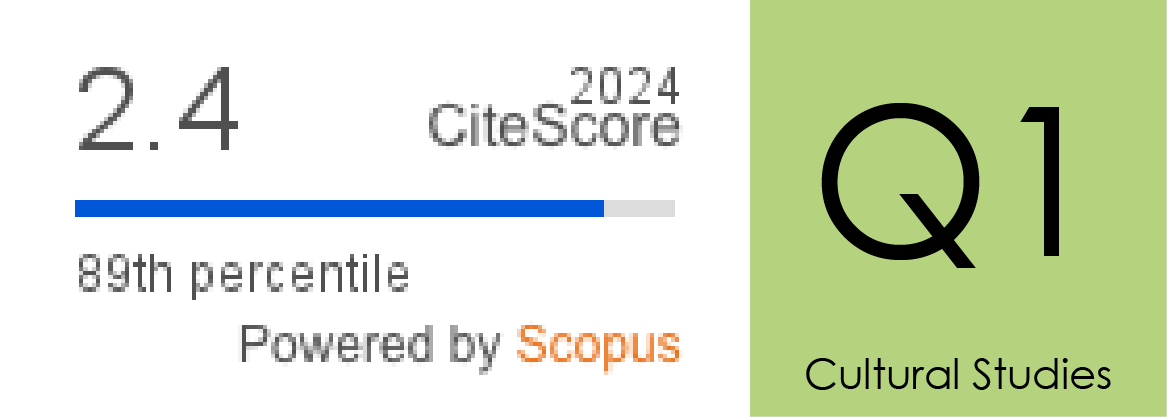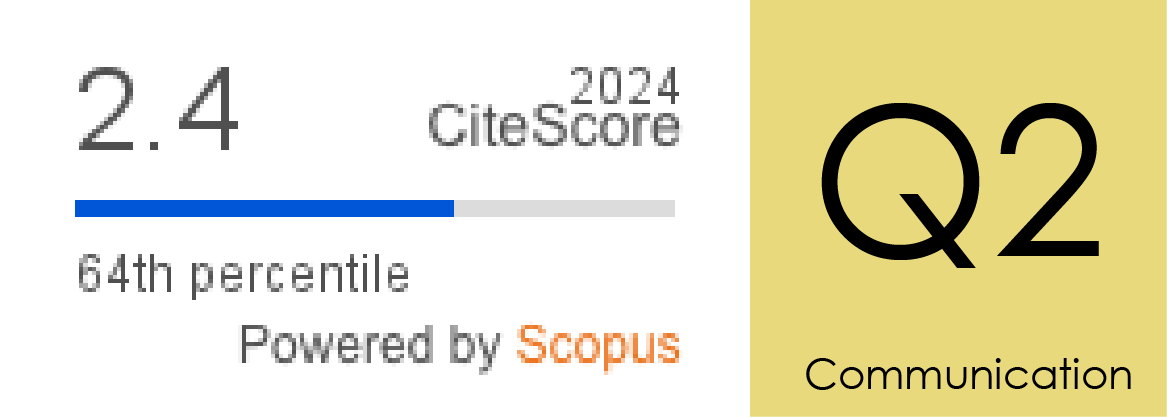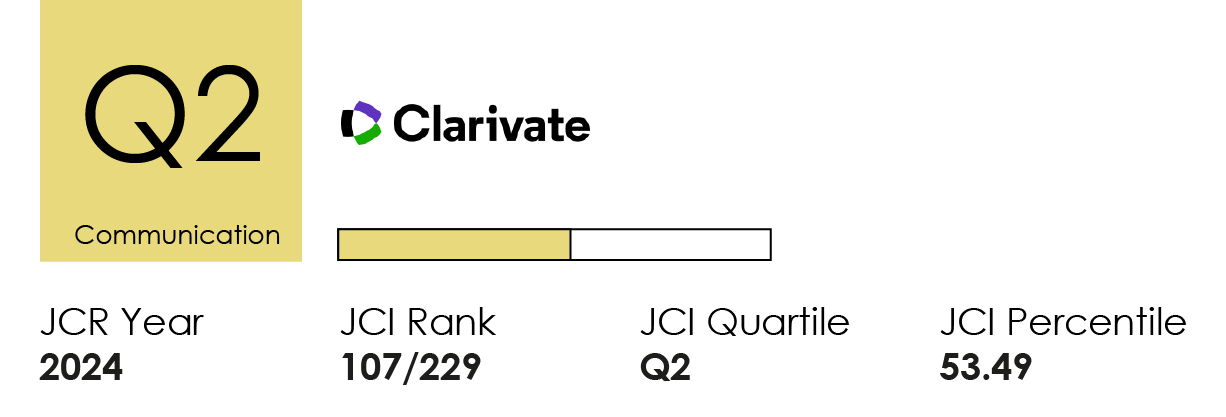A vacina no Instagram: estudo das emoções expressas no contexto brasileiro
DOI:
https://doi.org/10.14198/MEDCOM.24190Palabras clave:
vacunas, emociones, Instagram, BrasilResumen
Com a emergência da Covid-19, as discussões sobre vacinas passaram a ter maior repercussão em todo o mundo. Nas redes sociais, espaços em que diferentes públicos produzem conteúdos e expressam suas percepções e interesses, publicações sobre os imunizantes se tornaram um dos principais tópicos do debate público. Neste artigo, temos como objetivo identificar e analisar os sentimentos e emoções expressos em torno da vacina e dos processos de vacinação no contexto brasileiro durante os anos de 2020 e 2021. Para tanto, tomamos como recorte empírico uma amostra aleatória construída a partir de postagens públicas sobre o tema no Instagram, coletadas por meio da interface gráfica do Crowdtangle. O processo de classificação e identificação das emoções é realizado a partir dos descritores padronizados da Human-Machine Interaction Network on Emotion (HUMAINE), seguido pela adoção do modelo circumplexo (Core Affect Model) de Russell (2003). Como resultado, as análises dos dados apontam para a prevalência de emoções positivas como esperança e confiança em relação à vacina no cenário brasileiro, enquanto emoções negativas, como desaprovação e preocupação são identificadas no corpus no que se refere a fatores contextuais (a figura do então presidente Jair Bolsonaro, seus discursos e ações, assim como o avanço da Covid-19 e surgimento de novas variantes).
Financiación
Instituto Nacional de Comunicação Pública da Ciência e Tecnologia, Faperj, CnpqCitas
Ahmed, S. (2014). The cultural politics of emotion. Routledge. https://doi.org/10.4324/9780203700372
Almars, A. M., Atlam, E. S., Noor, T. H., Elmarhomy, G., Alagamy, R., & Gad, I. (2022). Users opinion and emotion understanding in social media regarding COVID-19 vaccine. Computing, 104, 1481–1496. https://doi.org/10.1007/s00607-022-01062-9
Aman, S., & Szpakowicz, S. (2007). Identifying expressions of emotion in text. In V. Matousek, & P. Mautner (Eds.), Text, speech and dialogue. Lecture notes in computer Science (pp. 196-205). Springer. https://doi.org/10.1007/978-3-540-74628-7_27
Amanatidis, D., Mylona, I., Kamenidou, I., Mamalis, S., & Stavrianea, A. (2021). Mining textual and imagery Instagram Data during the COVID-19 pandemic. Applied Sciences, 11(9), 4281. http://dx.doi.org/10.3390/app11094281
Barrett, L. F. (2017). How emotions are made: The secret life of the brain. Houghton Mifflin Harcourt.
Basch, C. H., & MacLean, S. A. (2019). A content analysis of HPV related posts on instagram. Human vaccines & immunotherapeutics, 15(7-8), 1476–1478. https://doi.org/10.1080/21645515.2018.1560774
Berger, J., & Milkman, K. L. (2012). What makes online content viral? Journal of marketing research, 49(2), 192-205. https://doi.org/10.1509/jmr.10.0353
Benetoli A., Chen T. F., & Aslani, P. (2017). Consumer health-related activities on social media: Exploratory study. Journal of Medical Internet Research, 19(10). https://bit.ly/3PKe3Iw
Benevenuto, F., Ribeiro, F., & Araújo, M. (2015). Métodos para análise de sentimentos em mídias sociais. In Short course in the Brazilian Symposium on Multimedia and the Web (Webmedia) (pp. 1-30). https://bit.ly/3Wntglu
Bok, K., Sitar, S., Graham, B. S., & Mascola, J. R. (2021). Accelerated COVID-19 vaccine development: milestones, lessons, and prospects. Immunity, 54(8), 1636-1651. https://doi.org/10.1016/j.immuni.2021.07.017
Boulos, M. N. K., Giustini, D. M., & Wheeler, S. (2016). Instagram and WhatsApp in Health and Healthcare: An Overview. Future Internet, 8(3), 37. MDPI AG. http://dx.doi.org/10.3390/fi8030037
Chou, W. S., & Budenz, A. Considering emotion in COVID-19 vaccine communication: Addressing vaccine hesitancy and fostering vaccine confidence. Health Commun, 35(14), 1718-1722. https://doi.org/10.1080/10410236.2020.1838096
Clarke, S., Hoggett, P., & Thompson, S. (2006). Emotion, Politics and Society. Palgrave Macmillan. https://doi.org/10.1057/9780230627895
Corbin, A., Courtine, J. J., & Vigarello, G. (2020). História das emoções: do final do século XX até hoje. Vozes.
Devillers, L., Vidrascu, L., & Lamel, L. (2005). Challenges in real-life emotion annotation and machine learning based detection. Neural Netw, 8(4), 407-22. https://doi.org/10.1016/j.neunet.2005.03.007
Douglas-Cowie, E., Cowie, R., Sneddon, I., Cox, C., Lowry, O., McRorie, M., Martin, J., Devillers, L., Abrilian, S., Batliner, A., Amir, N., & Karpouzis, K. (2007). The HUMAINE database: Addressing the collection and annotation of naturalistic and induced emotional data. In A. C. R. Paiva, R. Prada, & R.W. Picard (Eds.), Affective computing and intelligent interaction (pp. 488-500). Springer. https://doi.org/10.1007/978-3-540-74889-2_43
Duarte, T. B. (2020). Ignoring scientific advice during the Covid-19 pandemic: Bolsonaro’s actions and discourse. Tapuya: Latin American Science, Technology and Society, 3(1), 288–291. https://doi.org/10.1080/25729861.2020.1767492
Ekman, P. (1993). Facial expression and emotion. American Psychologist, 48(4), 384-392. https://doi.org/10.1037/0003-066X.48.4.384
Gallup. (2019). Wellcome Global Monitor 2018. Wellcome. https://bit.ly/3WiK4ty
Gonçalves, P., Araújo, M., Benevenuto, F., & Cha, M. (2013). Comparing and combining sentiment analysis methods. In Proceedings of the first ACM conference on Online social networks (pp. 27-38). Association for Computing Machinery. https://doi.org/10.1145/2512938.2512951
Greyling, T., & Rossouw, S. (2022). Positive attitudes towards COVID-19 vaccines: A cross-country analysis. PLoS ONE, 17(3), 1-25. https://doi.org/10.1371/journal.pone.0264994
Gu, S., Wang, F., Patel, N. P., Bourgeois, J. A., & Huang, J. H. (2019). A Model for Basic Emotions Using Observations of Behavior in Drosophila. Frontiers in Psychology, 10, 781, 1–13. https://doi.org/10.3389/fpsyg.2019.00781
Hofmann, S. G., & Doan, S. N. (2018). The social foundations of emotion: Developmental, cultural, and clinical dimensions. American Psychological Association. https://doi.org/10.1037/0000098-000
Hu, T., Wang, S., Luo, W., Zhang, M., Huang, X., Yan, Y., Liu, R., Ly, K., Kacker, V., She, B., & Li, Z. (2021). Revealing public opinion towards COVID-19 vaccines with Twitter Data in the United States: A spatiotemporal perspective. J Med Internet Res, 23(9), 1-17. https://doi.org/10.1101/2021.06.02.21258233
Kearney, M. D., Selvan, P., Hauer, M. K., Leader, A. E., & Massey, P. M. (2019). Characterizing HPV Vaccine Sentiments and Content on Instagram. Health Education & Behavior, 46(2_suppl): 37S-48S. https://doi.org/10.1177/1090198119859412
Kwok, S. W. H., Vadde S. K., & Wang, G. (2021). Tweet topics and sentiments relating to COVID-19 vaccination among australian Twitter users: Machine learning analysis. J Med Internet Res., 23(5), 1-16. https://doi.org/10.2196/26953
Liu, B. (2010). Sentiment Analysis and Subjectivity. In N. Indurkhya, & F. J. Damerau (Ed.), Handbook of Natural Language Processing (pp. 627-666). Chapman e Hall/CRC. https://doi.org/10.1201/9781420085938
Lombardo, G., Fornacciari, P., Mordonini, M., Sani, L., & Tomaiuolo, M. (2019). A combined approach for the analysis of support groups on facebook - The case of patients of hidradenitis suppurativa. Multimedia Tools Applications, 78(3), 3321–3339, http://dx.doi.org/10.1007/s11042-018-6512-5
Lwin, M. O., Lu, J., Sheldenkar, A., & Schulz, P. J. (2018). Strategic uses of Facebook in Zikaoutbreak communication: Implications for the crisis and emergency risk communication model. International Journal of Environmental Research and Public Health, 15(9), 1974. https://doi.org/10.3390/ijerph15091974
Manovich, L. (2017). Instagram and contemporary image. Manovich.net. https://bit.ly/3YKcSgu
Mahyoob, M., Algaraady, J., Alrahiali, M., & Alblwi, A. (2022). Sentiment analysis of public tweets towards the emergence of SARS-CoV-2 Omicron variant: A social media analytics framework. Engineering, Technology & Applied Science Research, 12(3), 8525–8531. https://doi.org/10.48084/etasr.4865
Milani, L. R. N., & Busato, I. M. S. (2021). Causas e consequências da redução da cobertura vacinal no Brasil. Revista de Saúde Pública do Paraná, 4(2), 157-171. https://doi.org/10.32811/25954482-2021v4n2p157
Monari, A. C. P., Santos, A., & Sacramento, I. (2020). COVID-19 and (hydroxy)chloroquine: a dispute over scientific truth during Bolsonaro’s weekly Facebook live streams. Journal of Science Communication, 19(7), A03. https://doi.org/10.22323/2.19070203
Monselise, M., Chang, C. H., Ferreira, G., Yang, R., & Yang, C. C. (2021). Topics and sentiments of public concerns regarding COVID-19 vaccines: Social media trend analysis. J Med Internet Res., 23(10), 1-20. https://doi.org/10.2196/30765
Newman, N., Fletcher, R., Robertson, C. T., Eddy, K., & Nielsen, R. K. (2022). Reuters Institute Digital News Report 2022. Reuters Institute. https://bit.ly/3PZI7QJ
Nobre, R. K. M., & Guerra, L. D. S. (2021). Recusa e hesitação vacinal e os seus efeitos para os sistemas universais de saúde. Journal Of Management & Primary Health Care, 12(spec), 1-2. https://doi.org/10.14295/jmphc.v12.1086
Obeica, I. C. O., & Martins, D. M. S. (2022). Análise de sentimentos em tweets: Um estudo de caso sobre a opinião das pessoas em relação a vacina em tempos da pandemia do Covid-19. Caderno de estudos em Engenharia de Software. 4(1), 1-21. https://bit.ly/3nsr5kl
Oliveira, T., Quinan, R., & Toth, J. P. (2020). Antivacina, fosfoetanolamina e Mineral Miracle Solution (MMS): mapeamento de fake sciences ligadas à saúde no Facebook. Revista Eletrônica De Comunicação, Informação & Inovação em Saúde, 14(1), 90-111. https://doi.org/10.29397/reciis.v14i1.1988
Orr, D., Baram-Tsabari, A., & Landsman, K. (2016). Social media as a platform for health-related public debates and discussions: the Polio vaccine on Facebook. Isr J Health Policy Res, 5(34), 1-11. https://doi.org/10.1186/s13584-016-0093-4
Paes, A., Brasil, V., & Massarani, L. (2022). Negacionismo Científico: Un Análisis del Twitter de Jair Bolsonaro en Marzo y Noviembre de 2020. Razón Y Palabra, 26(114). https://doi.org/10.26807/rp.v26i114.1929
Papacharissi, Z. (2014) Affective publics: Sentiment, technology and politics. Oxford University Press. https://doi.org/10.1093/acprof:oso/9780199999736.001.0001
Penteado, C. L. C., Ferreira, M. A. S., Pereira, M. A., & Chaves, J. M. S. (2021). #Vacinar ou não, eis a questão! As emoções na disputa discursiva sobre a aprovação das vacinas contra a Covid-19 no Twitter. Política & Sociedade, 20(49), 104-133. https://doi.org/10.5007/2175-7984.2021.85145
Pinto, P. A., Antunes, M. J. L., & Almeida, A. M. P. (2020). Instagram as a communication tool in public health: a systematic review. In 15th Iberian Conference on Information Systems and Technologies (CISTI) (pp. 1-6). https://doi.org/10.23919/cisti49556.2020.9140809
Pinto, P. A., Brasileiro, F. S., Antunes, M. J. L., & Almeida, A. M. P. (2021). COVID-19 no Instagram: práticas de comunicação estratégica das autoridades de saúde durante a pandemia. Comunicação Pública, 15(29), 1-18. https://doi.org/10.4000/cp.11288
Plutchik, R. (1962). The emotions: Facts, theories and a new model. Crown Publishing Group/Random House.
Recuero, R., & Soares, F. (2021). O discurso desinformativo sobre a cura do COVID-19 no Twitter: estudo de caso. E-Compós, 24(contínua), 1-29. https://doi.org/10.30962/ec.2127
Recuero, R., Soares, F., Vinhas, O., Volcan, T., Hüttner, L., & Silva, V. (2022). Bolsonaro and the Far Right: How Disinformation About COVID-19 Circulates on Facebook in Brazil. International Journal Of Communication, 16(24), 148-171. https://bit.ly/3Wnu5L6
Rezende, C. B., & Coelho, M. C. (2010). Antropologia das emoções. Editora FGV.
Rodas, C. M., Barros, S. E. T., Souza, R. A. S., & Vidotti, S. A. B. G. (2022). Análise de sentimentos sobre as vacinas contra Covid-19: Um estudo com algoritmo de machine learning em postagens no twitter. Rev. Saúde Digital Tec. Educ., 7(3), 24-44. https://bit.ly/3FOQWI8
Rodríguez-Orejuela, A., Montes-Mora, C. L., y Osorio-Andrade, C. F. (2022). Sentimientos hacia la vacunación contra la covid-19: panorama colombiano en Twitter. Palavra-chave, 25(1). https://doi.org/10.5294/pacla.2022.25.1.4
Rowe, S., Massarani, L., Gonçalves, W., & Luz, R. (2023). Emotion in informal learning as mediated action: Cultural, interpersonal and personal lenses. International Journal of Studies in Education and Science, 4(1), 73-99. https://www.ijses.net/index.php/ijses/article/view/50
Russell, J. A. (2003). Core affect and the psychological construction of emotion. Psychological Review, 110(1), 145–172. https://doi.org/10.1037/0033-295X.110.1.145
Schröder, M., Pirker, H., & Lamolle, M. (2006). First suggestions for an emotion annotation and representation language. In Proceedings of LREC 2006 Workshop on Corpora for Research on Emotion and Affect (pp. 88-92). https://bit.ly/3BUUDLf
Serrano-Puche, J. (2016). Internet and emotions: New trends in an emerging field of research. Comunicar, 24(46), 19-26. https://doi.org/10.3916/C46-2016-02
Siegert, I., Böck, R., & Wendemuth, A. (2014). Inter-rater reliability for emotion annotation in human-computer interaction: Comparison and methodological improvements. J Multimodal user interfaces, 8(1), 17-28. https://doi.org/10.1007/s12193-013-0129-9
Soares, F. B., Bonoto, C., Viegas, P., Salgueiro, I., & Recuero, R. (2021). Infodemia e Instagram: como a plataforma é apropriada para a produção de desinformação sobre a hidroxicloroquina? Revista Fronteiras – Estudos Midiáticos, 23(2), 89-103. https://doi.org/10.4013/fem.2021.232.07
Sonne, J., & Erickson, I. (2018). The expression of emotions on Instagram. In Proceedings of the 9th International Conference on Social Media & Society (pp. 380-384). https://doi.org/10.1145/3217804.3217949
We Are Social, & Hootsuite. (2022). Digital 2022 global overview report. https://bit.ly/3HUIbz8
Xu, Q. A., Chang, V., & Jayne, C. (2022). A systematic review of social media-based sentiment analysis: Emerging trends and challenges. Decision Analytics Journal, 3, 100073. https://doi.org/10.1016/j.dajour.2022.100073
Yang, X., & Sornlertlamvanich, V. (2021). Public Perception of COVID-19 Vaccine by Tweet Sentiment Analysis. In 2021 International Electronics Symposium (IES) (pp. 151-155). https://doi.org/10.1109/ies53407.2021.9594036
Zulfiker, S., Kabir, N., Biswas, A. A., Zulfiker, S., & Uddin, M. S. (2022). Analyzing the public sentiment on COVID-19 vaccination in social media: Bangladesh context. Array, 15, 100204. https://doi.org/10.1016/j.array.2022.100204
Descargas
Estadísticas
Publicado
Cómo citar
Número
Sección
Licencia
Derechos de autor 2023 Geilson Fernandes de Oliveira Oliveira, Luisa Massarani Massarani, Thaiane Oliveira Oliveira, Graziele Scalfi Scalfi, Marcelo Alves dos Santos Junior Santos Junior

Esta obra está bajo una licencia internacional Creative Commons Atribución 4.0.
Los autores y autoras que publican en esta revista están de acuerdo con los siguientes términos:
1 Derechos de autor. Los autores y autoras conservan sus derechos de autor, aunque ceden a la revista de forma no exclusiva los derechos de explotación (reproducción, distribución, comunicación pública y transformación) y garantizan a esta el derecho de primera publicación de su trabajo, el cual estará simultáneamente sujeto a la licencia indicada en punto 2. Los autores pueden establecer otros acuerdos adicionales para la distribución no exclusiva de la versión de la obra publicada en la revista, siempre que exista un reconocimiento de su publicación inicial en esta revista.
© Los autores.
2 Licencia. Los trabajos se publican en la revista sujetos a la licencia de Reconocimiento 4.0 Internacional de Creative Commons (CC BY 4.0); los términos se pueden consultar en https://creativecommons.org/licenses/by/4.0/
Esta licencia permite a terceros compartir (copiar y redistribuir el material en cualquier medio o formato) y adaptar (remezclar, transformar y crear a partir del material para cualquier finalidad, incluso comercial), siempre que se reconozca la autoría y la primera publicación en esta revista (Revista Mediterránea de Comunicación (RMC) / Mediterranean Journal of Communication (MJC), Universidad de Alicante, DOI de la obra), se proporcione un enlace a la licencia y se indique si se han realizado cambios en la obra.
3 Política de autoarchivo. Se recomienda a los autores que difundan sus trabajos a través de Internet para favorecer una circulación y difusión más rápidas y, con ello, un posible aumento en la citación y alcance entre la comunidad científica y académica, en las siguientes condiciones:
No se permite a los autores depositar en un repositorio institucional o temático, página web propia, etc., las versiones preprint (versión antes de ser evaluada) o postprint (versión evaluada y aceptada para su publicación) de sus trabajos antes de su publicación, pero sí el artículo final publicado (versión del editor).













